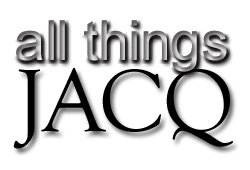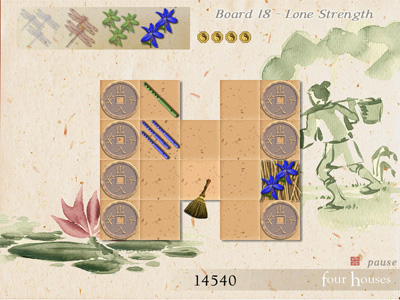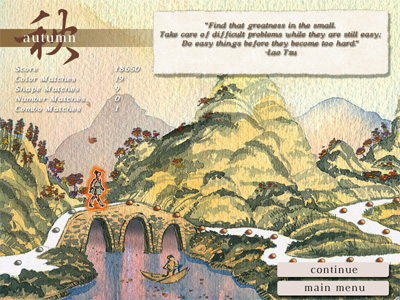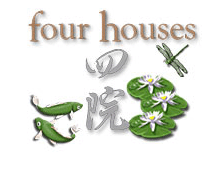 



There is certainly no shortage of matching puzzle games these days. Zuma, Bejeweled, and their thousands of mostly unoriginal offspring seem to be all the rage on Big Fish Games, PopCap, RealArcade, and the like. I suppose this stems from the fact that matching puzzle games are fun, but people eventually grew bored of the original designs and were looking for innovation. In general, what they got were a few nice alternatives and an abundant supply of uninspired rip-offs.
 Unlike Alchemy, Four Houses allows you to see what images are coming next. Unlike Alchemy, Four Houses allows you to see what images are coming next.There are two different play modes. In the Timed mode, matches add to the time you have left, and the level is complete when you've filled up the timer. In the Journey mode, each square on the board must be cleared at least once, and each square that's been used to make a match is marked with a Chinese coin; on upper levels the marking coins fade over time, but there is no 'loss of life' for allowing too much time to pass - it just means you have to make the matches again so that the board can be filled with coins.  Seasons change as you progress through levels, a very lovely touch. Seasons change as you progress through levels, a very lovely touch.It's graphically stunning, but not in the shiny overly-polished sort of way that's so common these days. The game is set on backdrops of watercolor paintings and realistic renditions of handmade paper, and to keep you from getting too bored, the backgrounds and types of images change a bit from level to level.  Chinese proverbs or quotations add to the meditative feel of the game. Chinese proverbs or quotations add to the meditative feel of the game.All of this is polished with a wonderful soundtrack that I would describe as New Age Orient - lots of Chinese strings and flutes coupled with occasional nature sounds. It's the sort of music that I tend to use in my yoga or meditation practice. I highly recommend downloading a trial version. Even if you can't afford the $20 for the game (or a Big Fish Game Club membership that allows you to get games for under $7), it's worth downloading just for the one hour of playtime that you'll get. Save it for a day when you need something soothing to help you unwind after a stressful day.
|

